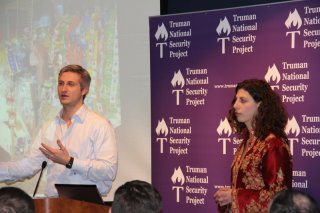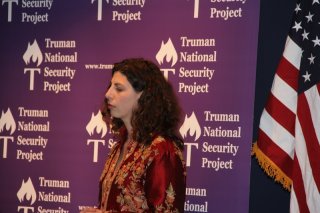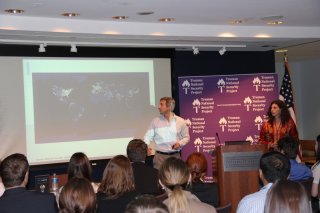Let There Be Light Launch Great Success
 Speaking to a packed room at the George Washington University’s Elliot School of International Affairs, Rachel Kleinfeld and Drew Sloan introduced their book, Let There Be Light: Electrifying the Developing World with Markets and Distributed Energy. More than seventy people listened with rapt attention as the two authors described how distributed energy, or energy disconnected from a central, national grid, can provide not only a marketable solution to the developing world’s energy poverty, but also provide crucial development that will keep America safe.
Speaking to a packed room at the George Washington University’s Elliot School of International Affairs, Rachel Kleinfeld and Drew Sloan introduced their book, Let There Be Light: Electrifying the Developing World with Markets and Distributed Energy. More than seventy people listened with rapt attention as the two authors described how distributed energy, or energy disconnected from a central, national grid, can provide not only a marketable solution to the developing world’s energy poverty, but also provide crucial development that will keep America safe.
 Drew Sloan currently works in the Client Solutions Department of the energy efficiency company, OPower, and was awarded two bronze stars and a purple heart for his service with the US Army in Afghanistan. Drew read an excerpt in which he recalls his realization of the importance of electrical power – particularly electric light – in the developing world. Standing watch at a military base in Afghanistan, Sloan realized that the brilliance of the stars in the Afghan sky, while stunningly beautiful, was a direct result of the lack of electric lights in the nearby village.
Drew Sloan currently works in the Client Solutions Department of the energy efficiency company, OPower, and was awarded two bronze stars and a purple heart for his service with the US Army in Afghanistan. Drew read an excerpt in which he recalls his realization of the importance of electrical power – particularly electric light – in the developing world. Standing watch at a military base in Afghanistan, Sloan realized that the brilliance of the stars in the Afghan sky, while stunningly beautiful, was a direct result of the lack of electric lights in the nearby village.
Since departing the military, Sloan has worked at both Rocky Mountain Institute under the direct tutelage of Amory Lovins as well and in the Commercialization Office at the National Renewable Energy Laboratory (NREL). Drew, who holds a Bachelor’s of Science in History from the United States Military Academy at West Point as well as an MBA from Harvard Business School and an MPA from the Harvard Kennedy School of Government, remarked that the real challenge the world has faced in providing energy to the developing world is a challenge of scale. While government-to-government assistance has funded massive energy development projects, sheer cost coupled with corruption have drastically decreased the efficacy of these programs.
 Dr. Rachel Kleinfeld, co-founder and CEO of the Truman National Security Project, explained a further benefit of distributed energy: matching the “product to the paycheck.” In order to create a demand for a product, said product cannot cost more than one paycheck of an ordinary person. Kleinfeld, who in 2010 was named one of the “Top 40 Under 40” Rising Political Leaders by Time Magazine, shared that in developing countries, manufacturers dramatically shrank the size of shampoo bottles so they could be purchased by the average consumer. Since the switch, single-serving shampoo packets have been flying off the shelves. A similar strategy ought to be applied to energy and energy infrastructure, argued Kleinfeld.
Dr. Rachel Kleinfeld, co-founder and CEO of the Truman National Security Project, explained a further benefit of distributed energy: matching the “product to the paycheck.” In order to create a demand for a product, said product cannot cost more than one paycheck of an ordinary person. Kleinfeld, who in 2010 was named one of the “Top 40 Under 40” Rising Political Leaders by Time Magazine, shared that in developing countries, manufacturers dramatically shrank the size of shampoo bottles so they could be purchased by the average consumer. Since the switch, single-serving shampoo packets have been flying off the shelves. A similar strategy ought to be applied to energy and energy infrastructure, argued Kleinfeld.
The pair stressed that the market would drive the energy revolution in the developing world, provided that the US and other providers would stop undercutting the nascent market by giving away faulty and poorly maintained energy solutions. If the world can ensure that solar panels, micro-hydro, and wind turbines are reliable, then slowly but surely consumers, especially businesses, will drive distributed energy onward.
 The United States military is well on their way to implementing these strategies at home. “With distributed energy projects, you can build plants at scale and ramp them up over time,” explains Tim Keating, VP of field operations and marketing at Skyline Solar, a Silicon Valley-based concentrated photovoltaic (CPV) company with contracts to develop solar plants at Edwards Air Force Base and Fort Bliss. “You can build one or two or three megawatts, and put those online in a local grid, so not only can you scale up over time, but you also don’t have to worry about all the issues associated with transmission. Thirty percent of power sent out on transmission lines is lost right off the top.” According to Forbes, “By generating energy onsite, the military can help to ensure resiliency and reliability in its energy supply, which is clearly preferable to the vulnerability inherent in using energy from a source the military does not control.” Kleinfeld and Sloan’s book seeks to take this model from American military bases and market it as a worldwide solution to the problems of energy-poverty.
The United States military is well on their way to implementing these strategies at home. “With distributed energy projects, you can build plants at scale and ramp them up over time,” explains Tim Keating, VP of field operations and marketing at Skyline Solar, a Silicon Valley-based concentrated photovoltaic (CPV) company with contracts to develop solar plants at Edwards Air Force Base and Fort Bliss. “You can build one or two or three megawatts, and put those online in a local grid, so not only can you scale up over time, but you also don’t have to worry about all the issues associated with transmission. Thirty percent of power sent out on transmission lines is lost right off the top.” According to Forbes, “By generating energy onsite, the military can help to ensure resiliency and reliability in its energy supply, which is clearly preferable to the vulnerability inherent in using energy from a source the military does not control.” Kleinfeld and Sloan’s book seeks to take this model from American military bases and market it as a worldwide solution to the problems of energy-poverty.
Sign Up and Stay Connected
On the Blog...
-
Gov Romney and Foreign Aid
27 Sep 2012
Written by Andrew Lubin, Foreign & Defense Analysis
Foreign policy in the 21st century is more than massive firepower; it’s the adroit use of defense, diplomacy, and development. Yesterday at the Clinton Global Initiative in New York, Gov Romney addressed ‘development.’
What Romney calls a [...]
-
Good Business Makes Strange Bedfellows
3 Aug 2012
Representative Steve Chabot (R-OH) just introduced H.R. 6178, which calls for the establishment of tighter working relationships between the U.S. government and private companies making vital progress in advancing economic growth and eliminating poverty in developing countries. What’s more, in accordance with common sense and defiance of all patterns, this [...]
-
Gov Romney and Foreign Aid
Sign Up and Stay Connected
On the Blog...
-
Gov Romney and Foreign Aid
27 Sep 2012
Written by Andrew Lubin, Foreign & Defense Analysis
Foreign policy in the 21st century is more than massive firepower; it’s the adroit use of defense, diplomacy, and development. Yesterday at the Clinton Global Initiative in New York, Gov Romney addressed ‘development.’
What Romney calls a [...]
-
Good Business Makes Strange Bedfellows
3 Aug 2012
Representative Steve Chabot (R-OH) just introduced H.R. 6178, which calls for the establishment of tighter working relationships between the U.S. government and private companies making vital progress in advancing economic growth and eliminating poverty in developing countries. What’s more, in accordance with common sense and defiance of all patterns, this [...]
-
Gov Romney and Foreign Aid
Sign Up and Stay Connected
On the Blog...
-
Gov Romney and Foreign Aid
27 Sep 2012
Written by Andrew Lubin, Foreign & Defense Analysis
Foreign policy in the 21st century is more than massive firepower; it’s the adroit use of defense, diplomacy, and development. Yesterday at the Clinton Global Initiative in New York, Gov Romney addressed ‘development.’
What Romney calls a “Prosperity Pact” is a re-labeling [...]
-
Good Business Makes Strange Bedfellows
3 Aug 2012
Representative Steve Chabot (R-OH) just introduced H.R. 6178, which calls for the establishment of tighter working relationships between the U.S. government and private companies making vital progress in advancing economic growth and eliminating poverty in developing countries. What’s more, in accordance with common sense and defiance of all patterns, this developmental measure and its counterpart [...]
-
Gov Romney and Foreign Aid



